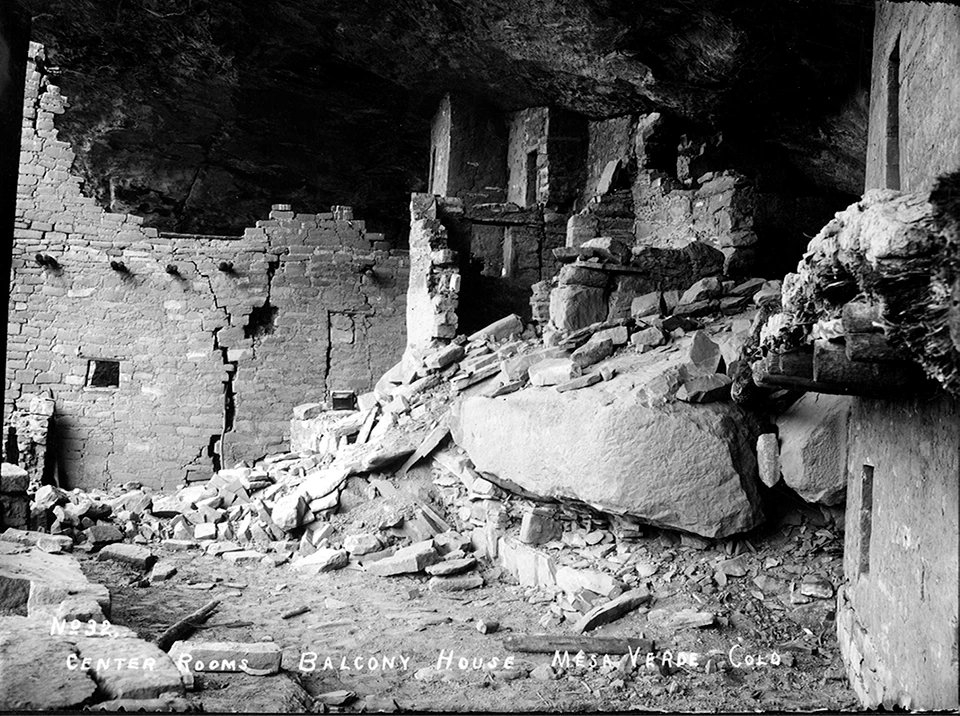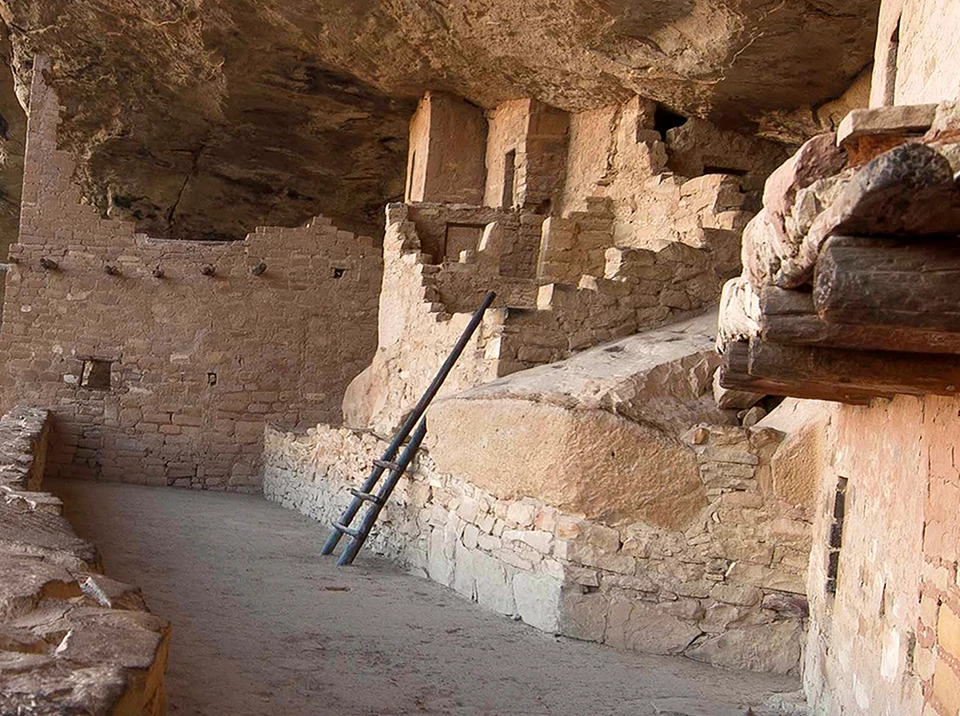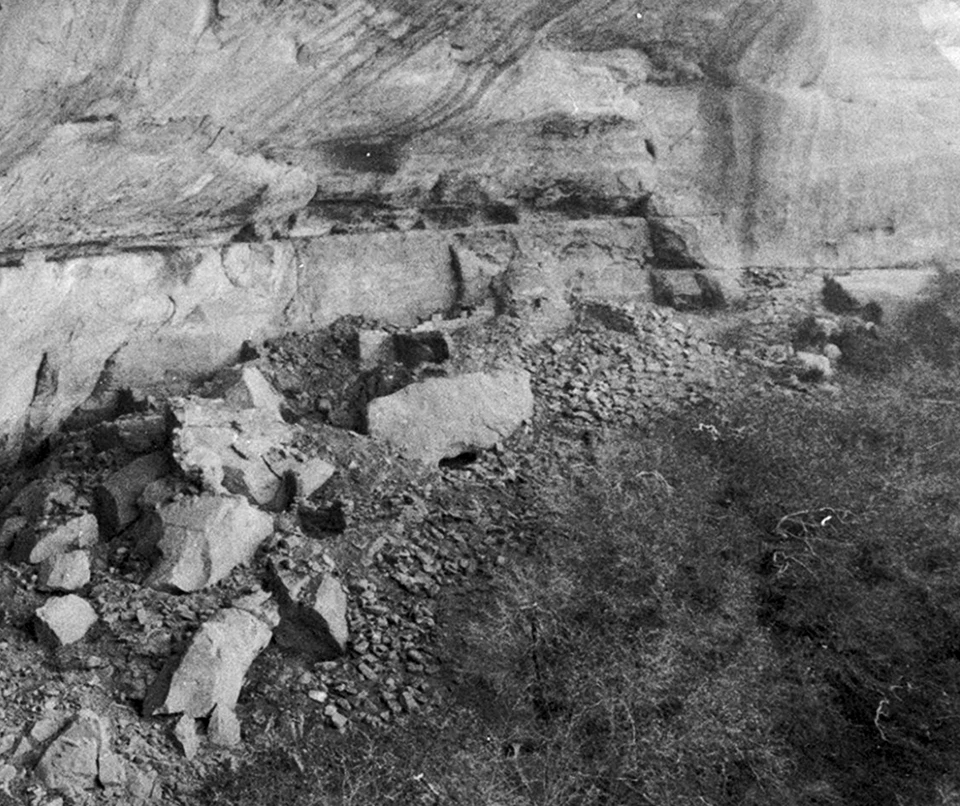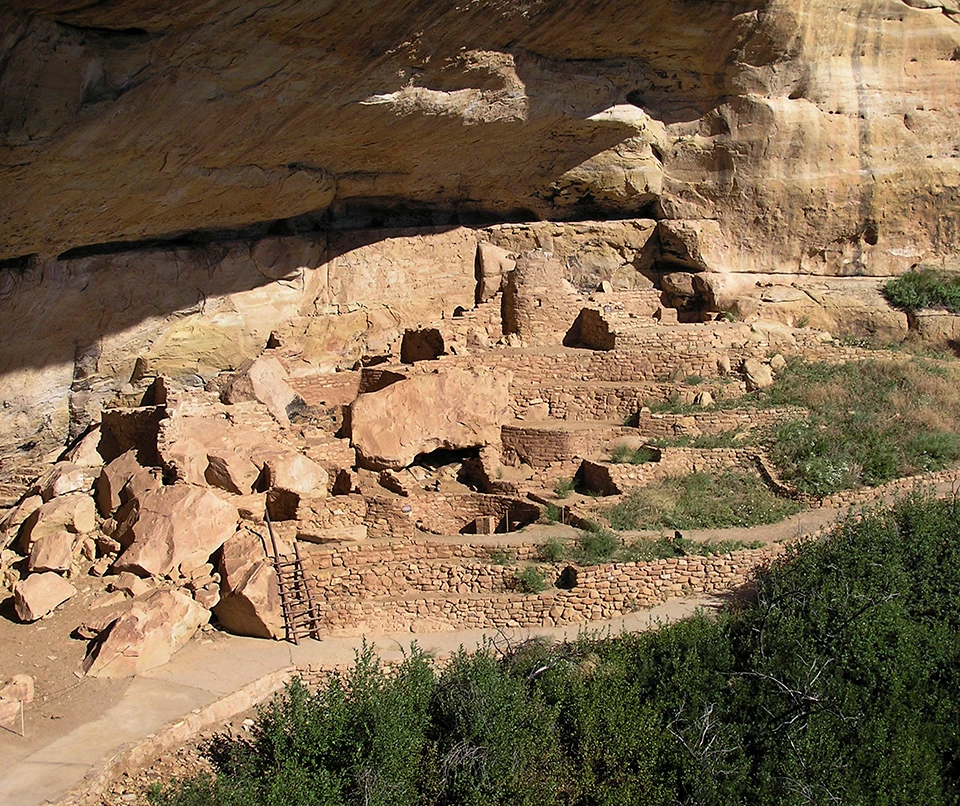A lot of careful planning, expertise, and physical labor goes into the preservation of the Ancestral Puebloan sites we are fortunate to experience today. Much of this initial work was accomplished in the eary 1900s and during the Wetherill Mesa Project of the late 1950s to early 1960s. But all archeological sites, especially those with standing architecture, require constant assessment and maintenance today. Natural factors such as rainfall and alcove spalling, as well as animals and insects, all impact the integrity of a site's fabric. Public sites in particular must be routinely monitored on an annual basis. We also ask visitors to help us in this effort by treading lightly and not leaning or sitting on ancient walls as they visit these fragile sites today. To learn how the park continues to preserve archeological sites for future generations, visit the Archeological Site Conservation Program.
Please scroll down or use the links below to compare the pre-stabilization condition of selected archeological sites with that of today. To compare each photo, look for a button with arrows in the center of each image. Use it to scroll back and forth between the historic and current day image of each site.
Balcony House Late 1880s and Balcony House Today
Left image
Balcony House, pre-stabilization
Credit: Thomas McKee. MEVE 9084, TM-53
Right image
Balcony House, post-stabilization
Credit: NPS Photo
A group of prospectors, led by S. E. Osborn, first entered Balcony House in the spring of 1884. Accompanied by W. H. Hayes and George W. Jones, the goal of their mission was to locate coal seams in nearby Mancos Canyon. Both Osborn and Hayes left their names in the site, with Osborn also leaving the date Mar 22, 1884. Hayes also later left his name across the canyon in Hemenway House on March 31. In later writings, Osborn describes some of the sites he visited in the Mesa Verde in 1883 and 1884.
Jesse Nusbaum excavated and stabilized Balcony House in 1910. Nusbaum was not only an accomplished archeologist, he was also one of the first superintendents of Mesa Verde National Park.
Balcony House was a mid-sized village of 38 rooms and two kivas and probably housed up to 30 people. Two naturally-occurring seep springs were located nearby, one within the alcove and one just below. Interestingly, its alcove faces northeast, which means the homes inside received little warmth from the sun during the winter months. Perhaps residents considered other needs, such as easy access to water, more important.
Back to Site Links ►
Cliff Palace Late 1800s and Cliff Palace Today
Left image
Pre-stabilization
Credit: Nordenskiold collection, MEVE 11084
Right image
Post-stabilization
Credit: NPS Photo
From the late 13th century to 1880s, Cliff Palace slowly deteriorated from the effects of water, wind, freeze/thaw cycles, differential fill levels, a variety of animals, spalling of the alcove roof, and the inherent qualities of the prehistoric structures themselves. Over the course of six centuries, Cliff Palace was visually transformed from an imposing assemblage of buildings,courtyards, and subterranean kivas to an array of stone structures rising from tons of rubble and debris. Still remarkably impressive, the effects of time were nevertheless evident. However, with the 'discovery' of Cliff Palace in the late 1800s, this gradual process of decay rapidly accelerated. Casual visitation and commercial exploration employed everything from pick and shovel to dynamite in an effort to recover all types of artifacts. In the end, the form and fabric of Cliff Palace was heavily damaged throughout its extent, with the natural processes of deterioration now altered by human activity. Visit Preserving Cliff Palace to learn more about the work involved in preserving this remarkable piece of American history.
With at least 150 rooms and 21 kivas, Cliff Palace is an exceptionally large cliff dwelling. It was surrounded by a vibrant, active community. Because of the large kiva to room ratio, some scholars suggest Cliff Palace was an important gathering place, perhaps an administrative enter for many Ancestral Pueblo villages. The people who lived in the area were familiar with dozens of footpaths that led from village to village and to storage structures, farming areas, water sources, and public buildings, such as Cliff Palace.
Long House late 1800s and Long House Today
Left image
Long House, Pre-stabilization
Credit: Nordenskiold collection, MEVE 11128
Right image
Long House, Post-stabilization
Credit: NPS Photo
Long House was excavated and stabilized between 1959 and 1961 as part of the Wetherill Mesa Archeological Project. This project, funded by the National Park Service and the National Geographic Society, excavated 15 sites on Wetherill Mesa between 1958 and 1963.
Long House is nearly equal in size to Cliff Palace with about 150 rooms, 21 kivas, and a row of upper storage rooms. It may have been home to 150 to 175 people. Some of the architectural features in Long House suggest it was also a public place where people from all over Wetherill Mesa gathered to trade or hold community events. The formal plaza in the center of the site is larger than most villages and has some features not often found in other Mesa Verde archeological sites. For instance, the benches, vaults, and a raised firebox may indicate that this large open space was a dance plaza or great kiva, similar to Fire Temple on Chapin Mesa. The high number of rooms and kivas in Long House, plus the presence of the formal plaza suggest the community was a particularly significant place for Ancestral Pueblo people, perhaps serving both civic and ceremonial functions.
Back to Site Links ►
Spruce Tree House, Pre-1907 and Spruce Tree House Today
Left image
Spruce Tree House, pre-stabilization
Credit: Nusbaum collection, MEVE
Right image
Spruce Tree House, post-stabilization
Credit: NPS Photo
Spruce Tree House was opened for visitation following excavation in 1908 by Dr. Jesse Walter Fewkes of the Smithsonian Institution. Dr. Fewkes removed the debris of fallen walls and roofs and stabilized the remaining walls.
Spruce Tree House is one of the best preserved cliff dwellings in the park. Due to the protection of the alcove, 90% of the material you see today is original so most of the walls, wood, and plaster are original. Archeologists have identified at least 120 rooms and eight kivas, making this the third largest cliff dwelling in the park. By the late 1270s, up to 19 households (60 to 80 people) lived here.
Spruce Tree House appears to have been constructed slowly, over time. Tree-ring dates from wood beams cut centuries ago, help archeologists map its growth. The first few rooms and a kiva were built on the far north side of the alcove, and remained this size for nearly thirty years. It took several more decades for the village to grow to the size you see today.
Back to Site Links ►
Step House, late 1800s and Step House Today
Left image
Step House, pre-stabilization
Credit: (MEVE-1532 RC-4-50 dr1 folder30a)
Right image
Step House, post-stabilization
Credit: NPS Photo
The Step House alcove contains six known Basketmaker III pit structures and a Pueblo III masonry pueblo with 27 rooms and 3 kivas. The first known excavation of Step House was by Gustaf Nordenskiõld, who was guided by local ranchers, the Wetherills in 1891. Although we now realize that some of the artifacts they discovered were from the earlier BM III period, they did not locate the pithouses and probably did not know about the earlier occupation.
Later in 1926, Park Superintendent Jesse L. Nusbaum and his crew excavated the first three pithouses. They were located beneath a midden that included a two- to six-foot-deep (0.6 to 1.8 m) layer of refuse such as animal bones and broken pottery that had been deposited by the later Pueblo III occupants some 500 years later.
In 1962, Robert Nichols and Al Lancaster worked at Step House as part of the Wetherill Mesa Project. They stabilized existing masonry structures and cleared trash and debris down to the alcove floor. A series of retaining walls running along the front of the masonry pueblo were discovered and restored or reconstructed. They also uncovered three additional pithouses, two of which were buried underneath the Pueblo III masonry pueblo.
Back to Site Links ►
|











